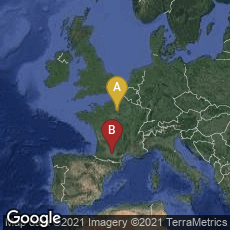

A: Paris, Île-de-France, France, B: Toulouse, Occitanie, France
French lawyer and amateur mathematician Pierre de Fermat owned a copy of the 1621 Paris edition of the Arithmetica by the ancient Greek mathematician Diophantus, edited by Claude Gaspard Bachet de Méziriac, and was in the habit of noting his own number theory propositions in the margins of the book. In 1637 Fermat made a marginal note next to one of the problems put forth by Diophantus, stating, in essence, that equations of the form xn + yn = zn have no whole-number solutions when n is greater than 2. In his note Fermat stated that he had found a truly marvelous proof (demonstratio mirabilis), which would not fit into the narrow margin of the book.
Fermat died in 1665 without revealing his proof known as Fermat's Last Theorem. In 1670 Fermat’s son published a second edition of Bachet’s edition of Diophantus from the press of Bernard Bosc in Toulouse that incorporated all of Fermat’s marginal notes and propositions, from which Fermat's Last Theorem became widely known. Today scholars doubt that he actually achieved it.
Most of Fermat’s propositions were proved during the 18th century, but the Last Theorem remained a stumbling block for succeeding generations of mathematicians, and by the early 19th century it had gained a reputation as perhaps the world’s most baffling mathematical mystery. “Simple, elegant, and [seemingly] impossible to prove, Fermat’s Last Theorem captured the imaginations of amateur and professional mathematicians for over three centuries. For some it became a wonderful passion. For others it was an obsession that led to deceit, intrigue, or insanity” (Aczel).
Hook & Norman, The Haskell F. Norman Library of Science and Medicine (1991) no. 777.